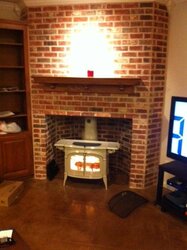We just moved into a home and inherited what I'm pretty sure is a Vermont Castings Encore. I found the manual on line and fired it up. I have several questions...... 
I'm currently burning hickory (not for long, this is my cooking wood but haven't had time to cut anything else) and the stove seems to consume quite a bit of wood but I have nothing to compare it to. My wood is 16" long and on average I'd say split to about 3" x 5" or so. This is a great size for my bbq pit but is it too small for my stove? Should I be splitting into bigger pieces? The manual says the wood should be 18-20" but I must have missed diameter recommendations if they're in there.
Also, once I get a good coal bed and the fire I am shutting off the damper to make use of the secondary burn as noted in the manual and I'm also shutting the intake damper (not sure of the proper name for this) down all the way when I do this hoping for longer burn times but it doesn't seem to do much. Is there an easy way to check if that damper is working? Do I have to take something apart?
Finally, how much wood do I put in? 3 or 4 pieces? Fill it up as much as I can? Somwhere in between? When filling it for the last time at night, I let it burn down to coals then put wood in, should I open everything back up until there's a rolling flame or do you leave it shut down?
Thanks guys for answers to any of these questions.

I'm currently burning hickory (not for long, this is my cooking wood but haven't had time to cut anything else) and the stove seems to consume quite a bit of wood but I have nothing to compare it to. My wood is 16" long and on average I'd say split to about 3" x 5" or so. This is a great size for my bbq pit but is it too small for my stove? Should I be splitting into bigger pieces? The manual says the wood should be 18-20" but I must have missed diameter recommendations if they're in there.
Also, once I get a good coal bed and the fire I am shutting off the damper to make use of the secondary burn as noted in the manual and I'm also shutting the intake damper (not sure of the proper name for this) down all the way when I do this hoping for longer burn times but it doesn't seem to do much. Is there an easy way to check if that damper is working? Do I have to take something apart?
Finally, how much wood do I put in? 3 or 4 pieces? Fill it up as much as I can? Somwhere in between? When filling it for the last time at night, I let it burn down to coals then put wood in, should I open everything back up until there's a rolling flame or do you leave it shut down?
Thanks guys for answers to any of these questions.


